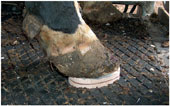It’s Not Worth Crying Over Spilled Milk – Determine Which Hoof Block Aids Your Dairy Farm
Just as your doctor recommends elevating your foot after injury, dairy farmers use hoof blocks to fight lameness. Rubber and wood hoof blocks help lift a cow claw off the ground after a foot-related injury.
Got Blocks?

Blocking is a helpful treatment option that utilizes hoof blocks when claws are over-trimmed and for any injured claw. Generally, hoof care professionals place wood or rubber blocks on a healthy claw to elevate and restrict the affected claw so that it heals. Blocking helps make cows more comfortable and allows them to recover quickly, impacting milk production.
Before hitting the woodwork, it’s important for dairy farmers to work with their hoof trimmers to consider the benefits of both blocking options for the cows they treat.
The Hard Facts About Wood Blocks
When treating lame cattle, wood blocks provide protection and comfort at a lower cost. Wood reacts well to bonding adhesives due to its rough surface and can last anywhere from three-to-five weeks.
Typically, wood blocks are less expensive than rubber blocks, allowing dairy farmers to save resources for other parts of their dairy operation. Wood blocks, made from either pine or hardwood, eventually fall off claws naturally, eliminating the need for hoof trimmers to go back to each cow to remove them.
Ideal for minor injuries, a wood block will wear itself down during the healing process and require little to no extra maintenance. However, wood blocks lack traction and durability putting cows at a higher risk of further injury and distress. Wood also tends to wear unevenly, which could disrupt an animal’s walk or weight distribution, resulting in continued lameness.
The Soft-Spoken Truth About Rubber Blocks

When utilizing blocking techniques, rubber blocks provide traction and comfort for wet and slippery surfaces. Rubber blocks, made out of a durable compound with a unique surface pattern, deliver the extra cushion needed for a cow to feel at ease during the healing process.
Typically rubber blocks are more durable than wood blocks, and on average, rubber blocks stay adhered on claws for more than six weeks after application. However, rubber blocks usually require a hoof care professional to remove them once an injury heals.
This type of block comes in a variety of heights and sizes to support specific claw injuries. Like a flat shoe, a thin rubber block allows a minor-injured cow to move in a mundane manner as the claw is lower to the ground. Whereas, like a high-heel, a thicker rubber block limits feet flow for more severe injuries. Rubber blocks can be easily trimmed and manipulated to adjust the course of a cow’s healing process.
Consider these factors when deciding what type of block to use in the fight against lameness. Talk to your hoof care professional about the importance of blocking, and the best options for your dairy environment. For more information about blocking solutions for your dairy farm, visit https://www.vettec.com/en-us/bovine.









